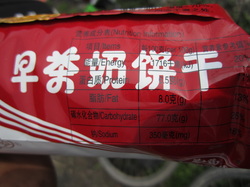Kellen Smetana
Last entry was about our individual experiences with food here, this post is meant to talk about what we see on a more widespread level. It’s tough to assess the typical diet because there are numerous street vendors hawking fresh fruit and honey, rice is ever-present, and there seems to be plenty of markets selling fresh meat; however, we have certainly been through enough supermarket equivalents to make a judgment about the food we have seen there.
What we see is a food pyramid flipped on its head. Everything is driven by sugar, sugar, sugar. The infinite number of Twinkie-equivalents advertise how healthy they are because the middle filling is egg based. Any sort of bread, muffins, and biscuits are actually just cake. And there is a brand called 30% Juice, probably highlighting the fact that it is 30 times more juice than the next best drink. I think it’s safe to say that Whole Foods does not have a Chinese market expansion plan in the near future.
Last entry was about our individual experiences with food here, this post is meant to talk about what we see on a more widespread level. It’s tough to assess the typical diet because there are numerous street vendors hawking fresh fruit and honey, rice is ever-present, and there seems to be plenty of markets selling fresh meat; however, we have certainly been through enough supermarket equivalents to make a judgment about the food we have seen there.
What we see is a food pyramid flipped on its head. Everything is driven by sugar, sugar, sugar. The infinite number of Twinkie-equivalents advertise how healthy they are because the middle filling is egg based. Any sort of bread, muffins, and biscuits are actually just cake. And there is a brand called 30% Juice, probably highlighting the fact that it is 30 times more juice than the next best drink. I think it’s safe to say that Whole Foods does not have a Chinese market expansion plan in the near future.
It’s sad to see a mass of food reduced to such a sorry state. The “fluff” is popular because of how cheap it is and it’s cheap because corn starch / corn syrup based products are cheap. Without getting too political, it’s also pretty easy to see the connection of this cheapness to gargantuan farm subsidies in the US, because they’re not growing any corn over here and many of the same companies are the ones dumping these products. A massive global trade network rearing its ugly tail.
I guess our hope is that the future results of this diet combined with increasing income levels across the country will bring about a change in taste. Given the mass of infrastructure construction we’ve seen, it’s sure to happen soon. Until then, we’re sticking to the street vendors.



 RSS Feed
RSS Feed